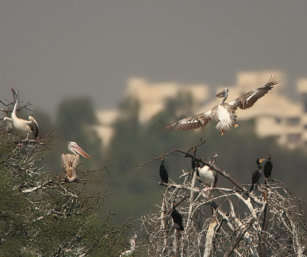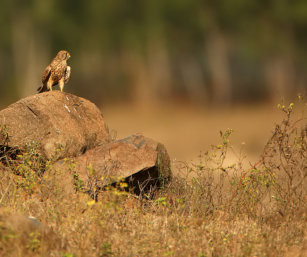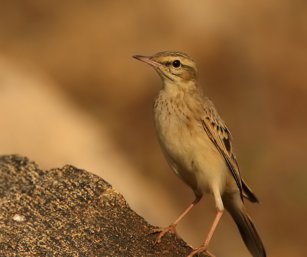Bangalore Bird Race, Jan 2008
Birding on steroids!
Sunday, January 19th was the second annual Bangalore Birdrace and I was part of the winning Red-throated Pipits team that consisted of Giri Cavale, Mike Prince and Deepak MK. Mike knew precisely how to go about winning the race and it was just going through the motions for the rest of us! Hats-off to Mike for his military-like planning & execution. The Bangalore birdrace had 35-teams and over 140-contestants participating.
Mike’s own words can best describe that crazy day of birding and he kindly agreed to give me permission to use his trip report pasted below– Our early morning visit to Nandi Hills for the Bangalore Bird Race was probably the best morning’s birding I’ve ever had there, and it was very difficult to tear ourselves away. We arrived at the lower slopes just before dawn having picked up five Spotted Owlets nearby in the headlights.
We stopped a few times on the way up with some good birds being Indian Scimitar Babbler, Crested Serpent Eagle (incidentally only the second I’ve seen here, and the first was on last year’s bird race!), White-bellied Drongo and a fantastic screaming flock of Alpine Swifts. Reaching the top we soon saw a fine white male Paradise Flycatcher (and then lost Ramki who went out of bird race mode to stay and photograph it!) and heard a Eurasian Blackbird. Red-throated and Tickell’s Blue Flycatchers were more of our target species soon knocked off, and we were pleased to get Tickell’s Leaf Warbler quite easily.
No luck with Indian Blue Robin though: only once before during the winter period have I failed to see or hear Indian Blue Robin here, and bizarrely that was last year’s bird race. Heading in to the main shola we were lucky to find Nilgiri Woodpigeon and then thought our luck was in as Giri glimpsed a bird, and Deepak and I both heard the rustling in the leaf litter, that he thought was an Indian Pitta. After patiently inching closer to the noise I managed to see a small part of the bird through the vegetation and was even more surprised to see that it was a male Pied Thrush! We all got good views of the bird which, with a few sightings here over the last three winters, is presumably a scarce winter visitor rather than just being a passage migrant.
Checking our watches we decided we’d better speed up back to the car and luckily en-route we saw an Orange-headed Thrush on the path. Then a small passerine flew up into a tree in front of us, showing a bright orangey tail: a Rusty-tailed Flycatcher. Otherwise plain in plumage it looked longer-tailed and longer-winged than a Red-throated or Asian Brown, and the tail (and upper-tail coverts) as it faced away from us was quite striking. Back in the car we stopped on the way down at the base of the cliff to try a track where I have seen Jungle Prinia and Jungle Babbler before. No luck with the latter but our luck was in because we saw a large raptor thermalling up the cliff which proved to be a juvenile Steppe Eagle.
As we watched we also saw an adult and an immature, and another two birds before we left. All of them spiralled up by the cliff before gliding off to the south. Finally just as we were about to leave I caught sight of a small bird fly onto a rock and a quick lift of the bins showed it to be a Sulphur-bellied Warbler, another rare bird here. True to the species it clung onto the underside of the rock, whilst also flying onto the trunk of a nearby tree and moving somewhat Nuthatch-like. Back on the main road some minutes later we looked back to check for more raptors and managed another three Steppe Eagles, making eight in total, plus an adult Bonelli’s Eagle looking quite small in comparison.
Oriental Honey Buzzard, Short-toed Eagle and Dusky Crag Martin were also good bird race birds seen here, and we left to head back towards Bangalore and our next stop… Second main stop for us was Jakkur Lake in order to pick up some ducks and other waterbirds that we weren’t expecting from other sites. I had been to visit a few waterbodies in north Bangalore the previous day so I knew that Jakkur Lake was looking very good, and so it proved. There were nearly 2000 ducks in total, mostly Shoveler but with several Pintail, Garganey and Lesser Whistling Duck. Unfortunately we weren’t able to find the single Common Pochard that was there the day before. Other wanted species though were seen, including Spot-billed Pelican, Darter, Painted Stork, Purple Swamphen, Common Moorhen and Common Kingfisher.
Two Greater Spotted Eagles were perched in the dead trees, a female Marsh Harrier flew over a couple of times and a Black-shouldered Kite was also seen. A couple of noisy Clamourous Reed Warblers were seen in the trees beside the road and in the edge of the reeds we were lucky to get good views of two Paddyfield Warblers, plus a fly-over Golden Oriole. No sign of the Pied Kingfisher or the Bluethroat that I had seen the day before, and these two species would elude us for the rest of the day. Pied Kingfisher was nearly our dip of the day, but not quite… A cross-country route brought us to Hessarghatta Lake in about an hour from Jakkur.
Being late in the day the lake (or rather, dry lake bed) had lots of disturbance from a large herd of cattle. We headed out to follow the water’s edge in order to find some waders, and managed the regular Little Ringed Plovers, Common Sandpiper, a few Wood Sandpipers and a single Temminck’s Stint. Often good for raptors here I looked up and saw an aquila eagle expecting it to be one of the usual Tawny Eagles. However this appeared not much larger than a Black Kite and too long and narrow-winged, ‘neater’ in proportions compared to Tawny. It differed from a Greater Spotted Eagle similarly, although plumage-wise resembled this species: from below the flight feathers were paler than the under-wing coverts with a prominent pale inner primary wedge and very clear white trailing edge.
There were narrow dark bars across the flight feathers. I’ve never seen Indian Spotted Eagle to my satisfaction (partly due to the fact that all the field guides are misleading and confusing) but having seen hundreds of the other aquilas the jizz of this bird looked distinctly different and I’m pretty sure that this was a juvenile Indian Spotted. (Incidentally Tawny Eagle was to elude us for the day.) As we walked along checking Paddyfield Pipits we eventually found a couple of the Blyth’s Pipits that have been wintering here, and even better since I knew we wouldn’t have time to get to the best area for them, five Greater Short-toed Larks flew over us. In the drier area I flushed a quail and got typical views as it flew directly away.
Walking to where it had landed it flushed again and I was able to confirm that there was no sign of any black below: it was therefore either a Common Quail or a female Rain Quail (pretty much indistinguishable in flight) and on balance of probability much more likely to be the latter. I spent some time checking the many hundreds of Barn Swallows and Red-rumped Swallows for Streak-throated Swallows which I had seen on my last two visits here. As I did so a small, all brown hirundine flew past that I immediately recognised as one of Plain or Sand (or theoretically Pale). It was slightly smaller bodied than a Barn Swallow with broad-based shorter wings and a slight fork to the tail. Below it could be seen to have a very well-defined brown breast band, widening slightly at the breast sides.
The white belly and, at times on a prolonged close view, the white throat could be seen. I’ve found these species to be quite variable sometimes in other parts of India and often difficult to identify: for example I watched a flock of at least 300 at Nameri in Assam last spring over a long period and could never convince myself 100% whether I was watching Sand Martins, or Plain Martins, or a mixed flock! At least this bird had such a well-defined breast band that it was clear (based on current identification and taxonomy knowledge) that it had to be a Sand Martin. Status of all these three species is unclear especially in south India: in Karnataka I believe there is just one previous unconfirmed report of Sand Martin.
Finally our last stop of the day was the eastern end of TG Halli, reached after a painfully slow drive from Hessarghatta. It did however add our only White-throated Kingfisher of the day, a bird we were starting to worry about! At TG Halli we managed several of the hoped for species including Greenshank, Black-winged Stilt and River Tern. Some trickier birds also presented themselves with both Booted and Sykes’s Warblers and a couple of Tawny Pipits. One eagle seen overhead may well have been one of the Tawnies usually seen here but frustratingly kept soaring up into the sun. We were luckier with a ringtail Montagu’s Harrier and also managed a male harrier which was so far off that I couldn’t be sure whether it was Montagu’s or Pallid.
This area is often good for Sykes’s Lark but all we could see were sizeable flocks of Oriental Skylarks. Finally we decided to head back to the car since we were running out of time and there just yards from the car was a single Sykes’s Lark. Feeling relieved about that I decided on one last scan of the distant shores and remarkably caught on to a flock of about 120 Bar-headed Geese. We then drove off, but not before Giri insisted on driving the Scorpio right down to the lake edge: he obviously knew something the rest of us didn’t for there we found an Asian Openbill. On the way back into Bangalore along the Magadi road we tried to work out what we could still add to our list with a bit of luck. Maybe some starlings flying over, a Pied Kingfisher over a roadside pool, or a White-breasted Waterhen skulking along the edges, or even a Greater Coucal somewhere? At one stage Ramki hesitatingly said “was that just a Coot?” as we passed another muddy village tank.
Almost as an afterthought we decided we’d better just reverse back to check it out and loud cheers rang out when it turned out to be a Waterhen! We totted up our total as 130 species, including some fantastic birds at each stop, and some great camaraderie throughout the day. As always a few common species were missed but we were extremely pleased with our efforts. Giri’s driving got us back early to the Manipal Centre so we contemplated hitting Cubbon Park for that elusive Coucal, but in the end decided we’d use the extra half an hour in the hotel bar for well-earned beers! Thanks are due to the other Red-throated Pipit team members, all the organisers and other participants. I’m now looking forward to some more relaxed birding for the rest of the year!
–Mike Prince Bangalore | Jan 2008
























































